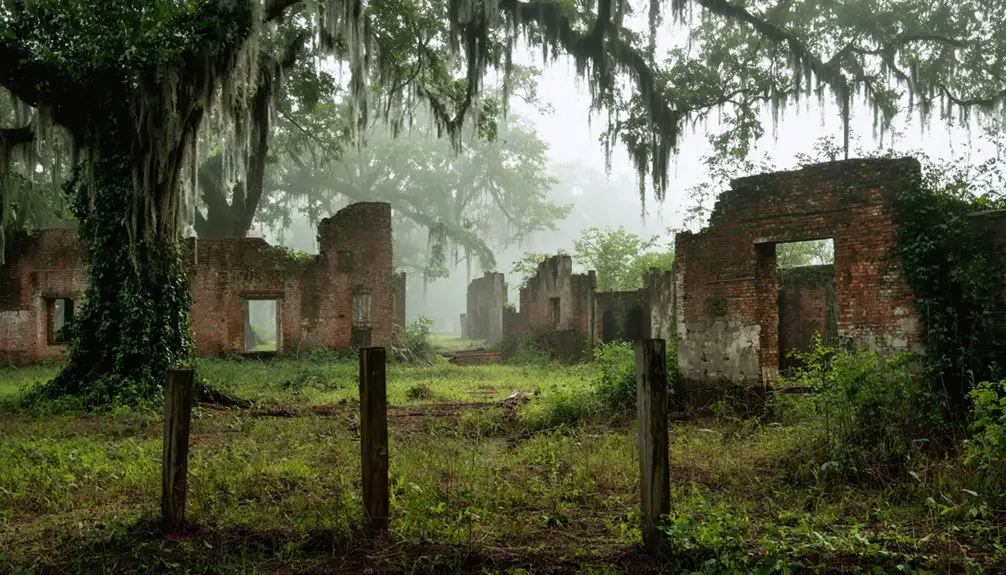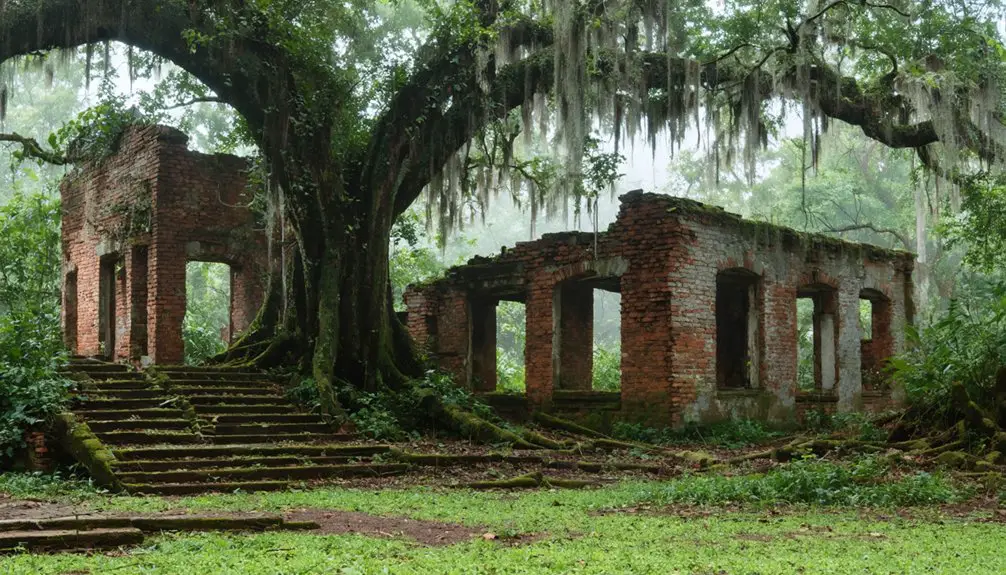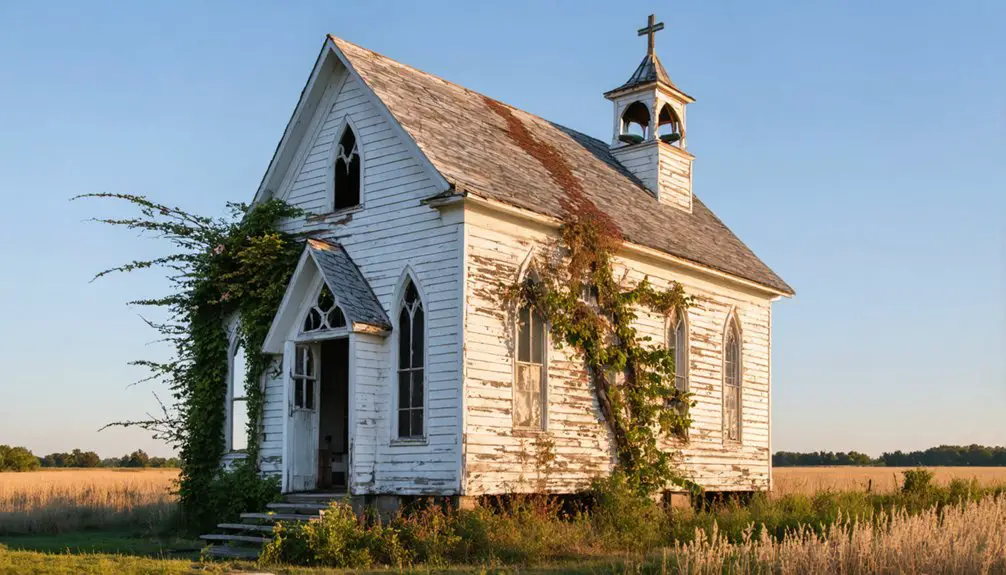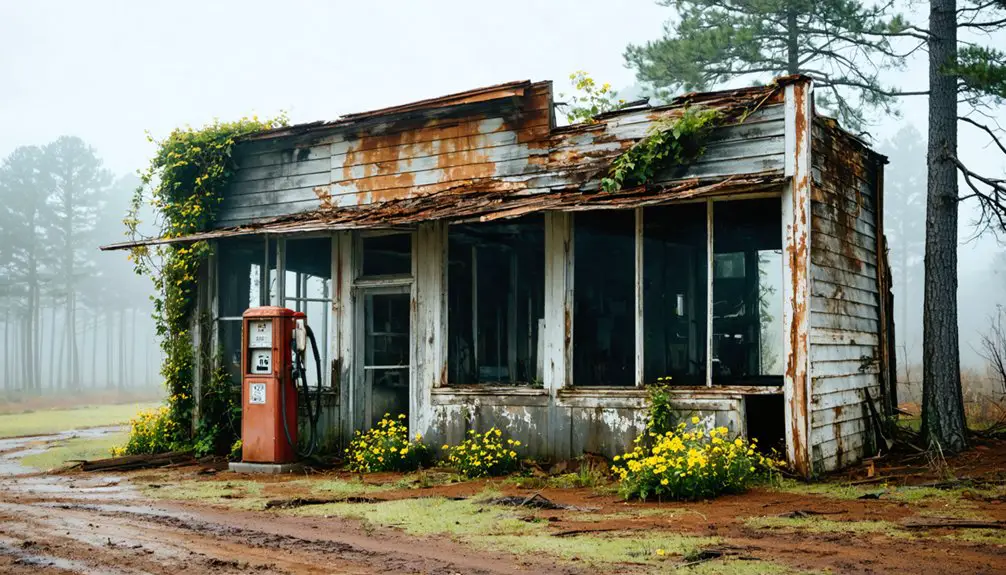You’ll find the ghost town of Selsertown nestled in Adams County, Mississippi, near the magnificent Emerald Mound. This former bustling settlement served as a crucial stop along the Old Natchez Road in the early 1800s, connecting Nashville to Natchez. What began as a Native American trading post evolved into a significant commercial center before declining in the late 19th century when railroads bypassed the area. The town’s rich legacy lives on through the second-largest prehistoric ceremonial mound in America.
Key Takeaways
- Selsertown was established around 1816 as Seltzer/Ellicotsville near the Mississippi River bluffs in Adams County, Mississippi.
- The town served as a significant hub for slave trading and cotton commerce during Mississippi’s territorial period.
- Population growth peaked between 1800-1840, followed by decline when railroad development bypassed the settlement.
- The site transitioned from Native American trading post to European-American settlement before eventual abandonment in late 19th century.
- Archaeological remains and the nearby Emerald Mound preserve the ghost town’s historical significance in Natchez District history.
Discovering the Lost Town of Selsertown
As you follow the winding roads of Adams County, Mississippi, you’ll discover the haunting remnants of Selsertown, a once-thriving settlement that served as an essential hub in the Natchez District‘s complex history.
Positioned strategically near the Mississippi River bluffs at 31.62806°N, 91.23611°W, Selsertown’s historical narratives weave together indigenous heritage and colonial ambitions. The Old Natchez Road connected the settlement to Nashville as its third designated stop.
At the intersection of bluffs and river, Selsertown marks where native ways and colonial dreams collided in Mississippi’s past.
Located just 32 miles from bustling Rodney port, the town benefited from the river trade that flourished in the region during the 1850s.
You’ll find yourself standing where the Natchez Bluffs Plaquemine culture once built impressive ceremonial mounds, marking their sacred spaces.
The town’s economic impact resonated throughout the region as it transformed from a Native American trading post to a significant slave market during the territorial period.
The settlement’s strategic location, combining elevated terrain with river access, made it a vital crossroads where indigenous, European, and American cultures converged before its eventual abandonment.
Archaeological Significance and Emerald Mound
You’ll find Emerald Mound‘s massive earthen platform rising 35 feet high and spanning eight acres, making it the second-largest prehistoric ceremonial mound in the United States.
Archaeological excavations since 1838 have revealed intricate pottery, tools, and human remains that paint a vivid picture of the Mississippian culture that flourished here between 1200-1600 A.D.
The mound’s remarkable preservation through centuries stands as a tribute to its robust construction methods, with its flat-topped pyramidal structure still clearly displaying the secondary mounds that once supported ceremonial buildings. The site was actively used for 350 years by the ancestors of the Natchez Indians. The site was stabilized and partially restored through preservation efforts by the National Park Service in 1955.
Platform Mound Construction Details
The Emerald Mound stands as a monument to the engineering prowess of the Mississippian culture, reaching impressive dimensions of 770 feet by 435 feet at its base and covering roughly eight acres of land.
You’ll find this massive platform mound rising 35 feet high, with two secondary mounds perched atop that bring the total height to 60 feet.
The construction techniques used by these ancient builders were remarkably effective. They’d gather soil using digging sticks and their hands, transport it in baskets to the site, and carefully tamp down each layer to guarantee stability.
This wasn’t a single building event – they constructed the mound in phases over centuries, sometimes building new layers over existing smaller mounds.
The result is a masterpiece of indigenous engineering that’s still standing after 800 years. As one of the largest mounds in North America, it served as an important ceremonial center for the local populations.
Cultural Artifacts Found Onsite
Inside this massive earthen structure, archaeological excavations beginning in 1838 revealed a treasure trove of artifacts that tell a rich story of Emerald Mound’s inhabitants.
You’ll find ceramic styles spanning over 500 years, linking the site to both Tunica and Plaquemine cultures from 1200 to 1730 CE. The burial practices revealed through excavations uncovered glass trade beads alongside traditional items like flint tools and pipes within the mound layers.
Animal bones and human remains provide insights into the community’s diet and health patterns. The site served as a ceremonial center for surrounding villages and hamlets. While you won’t discover any precious metals at this site, the extensive collection of pottery fragments and stone implements demonstrates the sophistication of Native American craftsmanship that flourished here before European contact.
Preservation Through Time
Since its initial excavation in 1838, Emerald Mound has revealed an extraordinary archaeological legacy spanning over eight centuries of Native American civilization.
You’ll find evidence of careful site management throughout its history, from early documentation of pottery and skeletal remains to modern preservation efforts by the National Park Service.
Archaeological techniques have evolved dramatically since those first explorations, with the 1972 excavations introducing advanced methods to study stratigraphy and animal remains.
Located six miles from Washington, Emerald Mound sits near the historic settlement of Selsertown, which was established by George Selser in the early 19th century.
When the site was donated in the 1950s, preservationists restored eroded secondary mounds and added visitor walkways.
Today’s management approach strikes a delicate balance between protecting this sacred earthwork and providing public access.
As the second-largest Pre-Columbian earthwork in the U.S., Emerald Mound continues to offer crucial insights into Natchez and Plaquemine cultural practices.
The Natchez People and Cultural Heritage
As you explore Selsertown’s historic landscape, you’ll discover the rich heritage of the Natchez people, whose paramount chief, the Great Sun, led a complex matrilineal society from ceremonial mound centers.
The Natchez maintained sacred perpetual fires atop their temple mounds, symbolizing both their sun-based religious beliefs and the divine authority of their ruling lineage. The tribe relied on farming and hunting to sustain their communities, cultivating crops like corn while pursuing deer and bear. The tribe’s Great Tattooed Serpent held significant power, overseeing matters of war and diplomacy for the Natchez nation.
These impressive earthen monuments served as the heart of Natchez political and ceremonial life until the early 18th century, when conflicts with French colonists led to the tribe’s tragic dispersal.
Native Leadership Structure
The Natchez people maintained one of the most sophisticated leadership structures among Native American societies, centered around the paramount chief known as the Great Sun.
You’ll find their leadership was deeply rooted in matrilineal succession, where power passed through the female bloodline. The Great Sun inherited his position as the first son of the Female Sun, while the War Chief managed military affairs.
The system balanced power through four primary Clan Mothers who wielded significant influence. They controlled family farms, influenced governance decisions, and guaranteed leadership continuity through their matrilineal lines. They were the only complex chiefdom society to survive initial European contact in the Mississippi Valley region.
This complex structure included two moieties that regulated marriages and social alliances, while lesser chiefs from the Sun royal family governed subordinate villages, creating a sophisticated network of authority and kinship.
Sacred Ceremonial Traditions
Within the sacred traditions of the Natchez people, elaborate ceremonial practices reflected their deep spiritual beliefs and strict social hierarchy.
You’ll find their most profound ceremonial rituals centered around the sacred temple mound, where a perpetual fire burned to symbolize the sun and divine ancestry.
Upon a chief’s death, complex funerary customs included sacred offerings and ritual sacrifices that maintained spiritual balance.
- Warriors, servants, and craftsmen often chose ritual suicide to accompany their deceased chief
- Sacred objects like rock crystal and ceremonial baskets held deep spiritual significance
- The temple’s dark interior, lit only by firelight, created an atmosphere of divine reverence
- Annual renewal of cane mats marked important cycles in their ceremonial calendar
Mound-Building Cultural Legacy
Spanning centuries of cultural development, Natchez mound-building practices flourished between 700-1730 AD across southwest Mississippi, leaving behind massive earthen monuments that still stand today.
You’ll find these impressive structures, like the Grand Village and Emerald Mound, showcasing the sophisticated engineering and spiritual dedication of these ancient peoples.
The mound symbolism reflects a complex belief system where sacred fires burned atop temple mounds, connecting the Great Sun’s lineage to cosmic powers.
These ceremonial practices weren’t just religious – they united dispersed farming communities through shared labor and ritual gatherings.
You can trace the Natchez’s cultural evolution from early hunter-gatherers to advanced agriculturalists through these earthworks, which served as platforms for elite residences and religious ceremonies, marking their transformation into a hierarchical society with organized leadership.
Historical Timeline and Settlement Pattern
Located in Adams County, Mississippi, Selsertown’s settlement pattern traces back to the region’s rich Native American heritage, specifically the Plaquemine culture’s construction of Emerald Mound around 1200 CE.
Nestled in Adams County, Mississippi, Selsertown emerged where the Plaquemine people built Emerald Mound eight centuries ago.
You’ll find that by the French colonial period, the Natchez people had abandoned Emerald Mound, shifting their capital to the Grand Village Site.
The town’s European-American settlement began around 1816, when it was known as Seltzer or Ellicotsville.
The area’s development followed typical Southern patterns:
- Proximity to Mississippi River trade routes attracted early settlers
- Cotton plantations drove economic growth through enslaved labor
- Population doubled between 1800-1840 as infrastructure expanded
- Late 19th century brought decline as rail transport bypassed smaller towns
This once-thriving community eventually succumbed to economic shifts, becoming one of Mississippi’s ghost towns.
Environmental Factors and Geographic Location

As you explore the environmental landscape of Selsertown, you’ll discover a diverse terrain shaped by the Mississippi River‘s influence, with loess bluffs rising approximately 400 feet above sea level.
These windblown silt deposits created fertile, well-drained hills that supported both indigenous mound-builders and later settlers.
The town’s geographic significance stems from its location at 31°37′41″N 91°14′10″W in Adams County, where environmental influences like the humid subtropical climate and abundant rainfall created ideal conditions for agriculture.
You’ll find evidence of nature’s power in the seasonal flooding that impacted settlement patterns and eventually contributed to the town’s abandonment.
The nearby wetlands and old river courses tell a story of changing waterways, while the proximity to the Natchez Trace enhanced the area’s strategic importance for trade and transportation.
Legacy and Preservation Efforts
Though Selsertown no longer exists as a functioning town, its legacy endures through the preservation of Emerald Mound, the second-largest Pre-Columbian earthwork in the United States.
You’ll find the site’s historical significance reflected in ongoing preservation efforts, despite numerous challenges.
- Archaeological studies dating back to the mid-19th century have documented the mound’s cultural importance.
- National and state heritage listings provide essential legal protection and funding support.
- Local historical societies actively promote awareness through educational programs and guided tours.
- Natural erosion and modern land use threaten the site’s long-term preservation.
Today, you can explore Selsertown’s rich heritage through interpretive displays and annual cultural events that highlight its role in Native American history and early American commerce.
Step back in time at Selsertown through engaging exhibits and cultural celebrations showcasing its Native American roots and trading history.
Despite preservation challenges, dedicated efforts continue to protect this invaluable piece of Mississippi’s past for future generations.
Frequently Asked Questions
Are There Any Remaining Buildings or Structures From Selsertown’s Post-Indigenous Settlement Period?
Like footprints washed away by time, you won’t find any remaining structures from post-indigenous settlement history here – no buildings or remnants survive beyond the ancient Emerald Mound itself.
What Modern Roads or Highways Provide Access to the Selsertown Site?
You’ll find highway access via U.S. 61 and Mississippi Highway 552, with local county roads providing final approach. Road conditions are well-maintained near the site, especially connecting from Natchez.
When Was the Last Documented Permanent Resident Living in Selsertown?
Like autumn leaves drifting away, the last resident of Selsertown faded from historical record during the early 1700s, as French colonial presence grew and the Natchez people relocated their capital elsewhere.
Did Any Famous Historical Figures Visit or Document Selsertown?
You won’t find records of famous historical visits to the site, though notable documents like Squier and Davis’s 1848 “Ancient Monuments” described its ceremonial mound as an archaeological feature.
What Natural Resources Originally Attracted Settlement to the Selsertown Area?
Like fertile soil embracing seeds of promise, you’d find the area’s rich floodplain perfect for cotton farming, while abundant timber resources provided materials for building your homestead’s foundation.
References
- https://www.wikiwand.com/en/articles/Selsertown
- https://en.wikipedia.org/wiki/Selsertown
- https://mississippifolklife.org/articles/haunted-by-a-ghost-town-the-lure-of-rodney-mississippi
- https://theforgottensouth.com/rodney-mississippi-ghost-town-history-tour/
- https://www.youtube.com/watch?v=C1OKWQ7a2zw
- https://www.youtube.com/watch?v=z7pw1Q-9s_E
- https://www.legendsofamerica.com/ms-rodney/
- https://exploresouthernhistory.com/natchezemerald.html
- https://www.historyhit.com/locations/emerald-mound/
- https://mythicmississippi.illinois.edu/native-illinois/emerald-mound/



